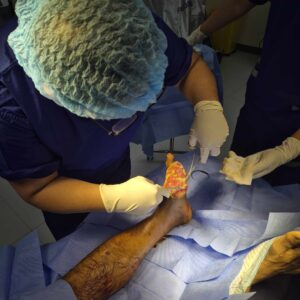Hips play a vital role in supporting the body’s weight, maintaining balance, and enabling smooth movement. They connect the legs to the pelvis, providing both stability and flexibility for daily activities such as walking, running, sitting, and bending. When hips function properly, simple actions like climbing stairs, standing from a chair, or dancing become effortless. Healthy hips are central to an active lifestyle, and their condition directly impacts overall quality of life.
Problems with hips can begin subtly, often starting as minor stiffness or discomfort. Ignoring early signs may lead to decreased mobility, affecting independence and everyday functioning. Recognizing the importance of hips and taking proactive steps to maintain their health is essential to prevent long-term limitations and chronic pain.
What Causes Hip Pain and Stiffness?
Hip pain and stiffness can arise from several factors, including aging, injury, overuse, and underlying medical conditions. Osteoarthritis is one of the most common causes, where the protective cartilage in the hip joint gradually wears away, causing pain, swelling, and reduced range of motion. Bursitis, tendinitis, and labral tears are other frequent issues that affect the soft tissues surrounding hips, leading to inflammation and discomfort.
Fractures and trauma can damage hips directly, often requiring surgical intervention for proper restoration. Lifestyle factors, such as prolonged sitting, poor posture, and inadequate exercise, can weaken the muscles supporting hips, increasing the risk of injury. Genetics also play a role, making some individuals more susceptible to hip joint degeneration. Addressing hip problems early with medical evaluation, exercise, and lifestyle adjustments can prevent complications and maintain mobility.
When Hips Start to Limit Movement and Daily Life
Hips affected by pain or stiffness can drastically alter daily life. Difficulty walking, climbing stairs, or even sitting comfortably are common experiences for individuals with hip conditions. Chronic hip pain often leads to compensatory movements, which can cause strain on other joints and muscles, creating a cycle of discomfort.
Emotionally, living with limited hip function can be frustrating and isolating. Many people feel restricted in their ability to participate in family gatherings, social activities, or physical hobbies. Simple joys such as playing with grandchildren, taking walks, or traveling may become difficult or impossible. Recognizing these limitations is an important step toward seeking solutions that restore hips to full function and relieve the burden of chronic pain.
Advanced Solutions for Hip Conditions
Hips can benefit from a range of treatment options, depending on the severity and type of condition. Non-surgical approaches often include physical therapy, targeted exercises, medications for pain and inflammation, and injections to reduce discomfort. These measures aim to improve flexibility, strengthen muscles supporting hips, and maintain joint health without invasive procedures.
When non-surgical treatments are insufficient, surgical solutions provide a path to restored mobility. Total hip replacement, partial hip replacement, and hip resurfacing are among the procedures designed to replace or repair damaged hip joints. Modern surgical techniques focus on minimizing tissue disruption, reducing pain, and promoting faster recovery. Individualized treatment plans ensure that hips receive the most appropriate care, tailored to each patient’s anatomy, lifestyle, and functional goals.
The Direct Anterior Approach (DAA): A Modern Way to Heal Hips Faster
The Direct Anterior Approach (DAA) has transformed hip replacement surgery by offering a minimally invasive option that preserves muscles and soft tissues surrounding hips. This approach reduces post-surgical pain, shortens hospital stays, and allows patients to regain mobility more quickly compared to traditional hip replacement methods.
DAA is particularly effective for patients seeking a faster return to daily activities and active lifestyles. The smaller incision and careful handling of tissues around hips contribute to better long-term outcomes, lower complication rates, and higher patient satisfaction. Surgeons at specialized centers use advanced imaging and precision techniques to ensure hips are aligned correctly, maximizing function and comfort.
Why Choose Hip Replacement Abroad?
Medical travel for hip replacement has grown as patients seek high-quality care at more affordable rates. Many international patients face long wait times or high costs for hip surgery in their home countries. Choosing a destination such as the Philippines allows access to expert surgeons, modern facilities, and cost-effective treatment options for hips without compromising quality.
Hospitals offering hip replacement abroad often provide packages that include surgery, hospital stay, and post-operative care at competitive pricing. International patient coordinators assist with travel arrangements, accommodation, and follow-up care, ensuring a seamless experience. Patients benefit from timely surgery for hips and comprehensive support throughout the recovery journey, reducing stress and maximizing the chances of a successful outcome.
Experience the Difference at Hips and Knees Joint Restoration and Replacement Center
Hips and Knees Joint Restoration and Replacement Center specializes in restoring mobility and relieving pain for patients with hip conditions. The center combines advanced surgical techniques, state-of-the-art facilities, and compassionate care to ensure optimal outcomes for hips.
Every patient receives a personalized treatment plan that considers the unique structure and needs of their hips. From initial consultation to post-surgical rehabilitation, the center focuses on achieving pain-free movement and enhancing quality of life. Experienced surgeons and therapists collaborate to support hips at every stage of treatment, ensuring a smooth and safe recovery process.
Life After Hip Surgery: Moving Freely Again
Recovery after hip surgery is an essential part of restoring function and independence. Physical therapy and guided exercises help strengthen the muscles supporting hips, improve flexibility, and maintain balance. Patients gradually return to daily activities, experiencing reduced pain and improved confidence in movement.
Successful hip surgery allows individuals to resume walking comfortably, climb stairs, participate in recreational activities, and enjoy an active lifestyle. Many patients report significant improvements in energy levels, mood, and overall quality of life once hips are fully restored. Maintaining a structured rehabilitation program ensures long-term hip health and prevents future complications.
Tips for Keeping Your Hips Healthy
Maintaining hips after treatment or as a preventive measure requires consistent attention to lifestyle and physical activity. Strengthening exercises targeting the gluteal muscles, hip flexors, and core help support hip joints. Regular stretching improves flexibility and range of motion.
Weight management reduces stress on hips, preventing degeneration and prolonging joint health. Balanced nutrition, including foods rich in calcium, vitamin D, and anti-inflammatory nutrients, supports bone and joint function. Avoiding prolonged periods of inactivity and practicing proper posture during daily activities also protects hips. Routine check-ups allow early detection and management of potential hip issues, ensuring sustained mobility.
Takeaway
Hips are essential for movement, stability, and quality of life. Chronic pain or degeneration should not limit everyday activities or independence. Expert care, modern surgical techniques, and focused rehabilitation provide a path to restored mobility and pain-free living.
Choosing specialized treatment for hips, whether through surgery or non-surgical interventions, allows individuals to return to active, fulfilling lives. Hips and Knees Joint Restoration and Replacement Center offers compassionate, expert care designed to help patients move freely again. Contact the center today to explore treatment options and start the journey toward stronger, healthier hips.
Frequently Asked Questions About Hip
1. How do I know if I need hip surgery?
Persistent pain that affects daily activities, reduced mobility, and limited response to non-surgical treatments are indicators that hip surgery may be necessary.
2. What makes the Direct Anterior Approach different?
The DAA technique preserves surrounding muscles, reduces post-operative pain, and allows faster recovery compared to traditional hip replacement methods.
3. How long does it take to recover after hip replacement?
Recovery varies depending on the procedure and patient factors, but most patients regain significant mobility within 4 to 6 weeks, with continued improvement over several months.
4. Is traveling abroad for hip surgery safe?
Yes. Reputable international centers follow strict safety and quality standards, with experienced surgeons and comprehensive care plans for hips.
5. What kind of post-surgical support is available for hips?
Centers provide physical therapy, rehabilitation guidance, teleconsultations, and follow-up care to ensure hips heal effectively and patients regain full function.
6. How can I maintain healthy hips long-term?
Regular exercise, proper nutrition, weight management, avoiding injury, and periodic medical check-ups are essential for long-term hip health.






